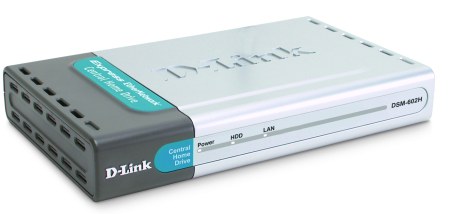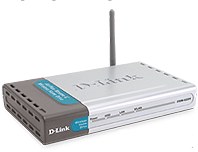Device Profile: D-Link “Central Home Drive”
Sep 16, 2003 — by LinuxDevices Staff — from the LinuxDevices Archive — 4 viewsDigital home communications technologies specialist D-Link worked with Intel to build an innovative “Central Home Drive” that leverages an embedded Linux operating system and Universal Plug-n-Play (UPnP) technology to create a network-attached repository for shared multimedia files in the home that works in heterogeneous networks out of the box. The device will ship mid-October 2003 with an MSRP of $249.99.

D-Link's Central Home Drive
What is it, and what can it do?
D-Link's Central Home Drive (CHD) is a network-attached storage device for home use measuring 19cm x 11.5cm x 3cm (in inches, 7.5 x 4.5 x 1.125). An optional 802.11g wireless interface is available, or it can be wired into 10/100Mbps Ethernet networks. ANSI/IEEE 802.3 NWay auto-negotiation is supported.

D-Link DSM-622H with 802.11g wireless
Once online, the device adds network share volumes on the desktops of all networked PCs, according to D-Link, which says the device supports Win2K/XP, Mac, and Linux clients and can hold 5,000 MP3s or 20,000 high-resolution JPEG images.
Web-based configuration requires a late-model browser with Java support and enables users to change network settings, system settings, access permissions, and passwords. The Web interface additionally supports reboots and shutdowns, drive formatting and scan disk, event logging, and firmware upgrades.
D-Link attributes the CHD's alleged ease of use to its implementation of UPnP technology, a standards-based technology for transparent network device connectivity that allows devices from various vendors to “just work” when plugged into the network. UPnP standards are administered by The UPnP Forum, an industry consortium boasting 617 members.
What's inside?
The CHD is based on an Intel XScale IXP420 chipset with high performance processing and low power consumption. The CPU is clocked at 266MHz, with 32MB of 133MHz SDRAM. 8MB of CompactFlash serves as the boot device, with start-up requiring about 30 seconds. An upgradable 2.5-inch 20GB slim hard drive provides storage.
The device runs MontaVista Linux, with kernel version 2.4.18. Other software includes . . .
- ext3 journaled filesystem
- HTTP server
- Samba server
- DHCP client
- UPnP client
Additional detailed specs are available online.
D-Link has yet to produce power consumption or noise emissions data for the device, but is working to incorporate a power-saving mode with drive spin-down in future revisions, according to Hansheng Tan, product manager for the CHD. The power supply max on the current model is 15 watts, and Tan calls the device “very quiet compared to other NAS systems.”
Why Linux?
Tan says D-Link chose Linux because it was free and because Linux gave them full control over all the software. His team got Linux running on the device without hiring an embedded Linux company or specialist. But, there were challenges “mostly in the BSP,” according to Tan. Tan adds, “Both Intel and Monta Vista provide great support in their IXP4xx solution for developers.”
According to Tan, D-Link has launched several other products running embedded Linux, including the AirSpot DSA-3100 Hotspot Gateway. Tan says D-Link is porting some software from VxWorks to embedded Linux, mostly for VPN/firewall and residential gateway applications.
Tan calls his experience using Linux for this project “very positive,” and adds, “Embedded Linux will become more and more popular, that's for sure.”
This article was originally published on LinuxDevices.com and has been donated to the open source community by QuinStreet Inc. Please visit LinuxToday.com for up-to-date news and articles about Linux and open source.